Failure of Metals under Long Term Static Loads
| ✅ Paper Type: Free Essay | ✅ Subject: Mechanics |
| ✅ Wordcount: 3339 words | ✅ Published: 23 Sep 2019 |
Failure of metals under long term static loads
Introduction
Metals are an important factor in almost every aspect of contemporary life, as such it is essential that designers have sufficient knowledge of the behaviour of these materials when subjected to different types of loads in a variety of environments (Gere and Goodno 2012). In practical terms a metal component is designed to withstand static and imposed loads over the service life of that component, with the designer taking account of the environment in which the metal is located and the type of load, as well as other factors such as impacts and corrosion, which could affect the performance of the material. The design will also include a factor of safety to optimise the achievement of the design life in safe manner (Bhaduri 2018).
Madia et al.,(2017) suggests that the failure of a metal is dependent on the static and imposed loads on the material over the life of that material, with Zerbst et al.,(2019) adding that approximately 90% of the incidents are due to fatigue. In many cases, such failure is linked to fatigue cracks started by at geometrical defects such as holes and notches. Failure can also be due to irregularities in the metal such cavities, voids, corrosion pits and inclusions, which are often the root cause of component failure. Forrest (1970) points out that failure of metal by fatigue is typically the result of loads that are either repeated or varied, and where the maximum amount load that causes failure is significantly lower than the static breaking load. The fact is that in service life, many metal structures and components are subjected to varying loads and whilst the average induced stresses are generally low and do not decrease the static strength, failure may still occur due to fatigue. Forrest (1970) therefore argues that there are a greater number of failures in service due to fatigue than due to static failure.
However Martin and Vladimír (2017) point out that the conditions assumed in the design stage, may alter over the long term life of the metal, as such it is essential to understand the potential environmental and operational conditions which affect both static and dynamic loading on materials. Panin et al.,(2017) agree, adding that it is important to understand the impact of long term static loads on metals as this can have a major effect on structures and pipelines over time, citing the example of long term static loading on steel gas pipelines.
The aim of this essay is to explore failure in metals under long term static loads, focusing on static loading on alloys. This essay asks how long term static loading can affect the mechanical properties of these materials. The essay continues with a brief resume of the key mechanical properties of metals before discussing studies on static loading on alloys.
Mechanical Properties of Metals
Lascoe (1998) maintains that metal structures can be manufactured and constructed using a variety of metals ranging from carbon steel to cold-formed steel to stainless steel and aluminium. The stress-strain curves of each of these materials is different, with different yield values and post-yield criteria, as shown in Figure 1. It is evident form the above figure, that for example high strength steel and stainless steel have a rounded behaviour with no yield plateau compare to mild steel (Ellobody et al.,(014). Macaulay (2012) agrees, pointing out that some materials have a well-defined yield stress, exhibiting linear elastic behaviour, prior to plasticity and failure. However there are also other materials where the end of the elastic behaviour is not clear-cut. Furthermore, time-dependent behaviour in the elastic-plastic region is negligible for metals under static loading, however behaviour is dependent on a range of factors including temperature, which will induce creep. The point being that structural performance of a metal is dependent on the micro-structure and macro-structure of the material, as well as properties such as strength under static and dynamic loading, hardness and ductility.
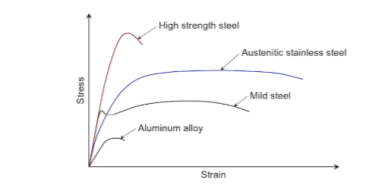
Figure 1. Stress-strain curves of different metals (Ellobody et al., 2014, p.4, Figure 1.1)
Hosseini et al.,(2015) point out that during service, a metal structure can be damaged through a number of events, and loading condition. Once a structure is even partly damaged this can affect the energy absorption, ductility and strength of the metal. These load scenarios include high strain, static, seismic or thermal loadings. Static loading can occur due to factors such as foundation settlement which can occur over time and which is a common cause of damage to the structures causing large relative displacements in a metal which ultimately push the material beyond its yield point. Other forms of large static loads include lateral ground water pressure in relation to temporary loads and bridge piers imposed in repair processes. The point being that these loads result in strain ageing, and it is submitted that static load- induced strain ageing can considerably change the mechanical properties of metals such as steel material. It is acknowledged that static loads and strain ageing are considered at the design stage, both in the manufacturing of the metal and in the choice of the materials.
Hosseini et al.,(2015) explain that the place that the strain aging effect takes place in metal starts with the movement and formation of linear defects within the microstructure of the material, referred to as dislocations. It is noted that the strength of a metal is related to the microstructure of the metal and is essentially managed by the stress that is needed to make dislocations move in the microstructures for considerable distance. For example in steels, the presence of carbon and nitrogen are key factors in mechanical properties and behaviour of the material, from which it follows that these substances also have a role in strain ageing over the long term static loading of steel. In other words, the behaviour of the metal in ageing depends on time, with short term aging and long term aging, where the latter relates to the time because of a phenomenon like creep in the material which takes place in a very long time. The problems of long term ageing is that it is difficult to predict the changing conditions to which a metal is subjected, as the mechanical properties of the material can be altered by external forces such as a corrosive environment which makes it difficult to state the exact impact of long term static loads on failure.
Harris (2014) makes a similar point, noting that the microstructure of the material, has a profound effect on behaviour under long-term static loading. This is in turn is influenced by the method production, and the processes which are used to manufacture the metal. These process are essentially deformation processes seeking to transform solid materials from one shape into another. The original shape might by simple such as a billet or a sheet, which is then plastically deformed using heating processes, tooling and dies, to obtain the desired final geometry. In addition the deformation process typically involves additional operations such as casting and machining, grinding and heat treating, to transform the raw material into the finished metal part or component (National Academy Press 1995). The point being that each of these processes affects the mechanical properties of the metal and ultimately the behaviour of that material under long term static loading (Harris 2014).
Whilst there has been significant research on the impacts of long term static loads on conventional metals it is argued that there has been little research on alloys. Yet Winzer et al., (2005) point out that alloys play an increasingly important role in industry, with for example magnesium (Mg) alloys being used in a diverse range of applications from the automobile industry (Matta et al., 2018) to medical implants (Witte 2010). For example Mišović et al., (2016) point out that alloys such as aluminium alloys do not have a long tradition in engineering however the elastic and yield limits of these materials can greater than those of ordinary structural steel elements. In addition alloys are typically corrosion resistant and are lighter than conventional metals, facilitating transportation and assembly. These materials also exhibit resistance to brittle fracture within low temperature ranges and have minimal susceptibility to temperature gradient and residual stress. In short these materials could be useful in improving performance under long term static loading. It is prudent therefore to explore the impacts of long term static loading on these materials.
Long Term Static Loading on Alloys
Fedirko, et al., (2014) point out that titanium-based alloys are structural materials that exhibit high physico-mechanical characteristics, including specific strength and resistance to corrosion in aggressive environments. However as with conventional metals, a key issue in the strength and durability under loading is the method of production. For instance a current area of concern is the formation of interstitial impurities in solid solutions which is caused by the gas saturation around the surface of the metal, which affects the serviceability of the products. There are several proposed solutions to this problem including the method of surface hardening that can potentially enhance the corrosion resistance and to improve the wear resistance of the metal. However some research suggests that this process will increase the brittleness of the alloy, thereby decreasing the ability to resist deformation and fatigue. In short there is no consensus on the optimal method for improving the serviceability of titanium alloys in service of static loading and fatigue, prompting Fedirko, et al., (2014, p.415) to research gradient hardening and how it can potentially influence on the durability of titanium alloys under a variety of load conditions.
The study involved the use of industrial α titanium alloys including OT4-1 pseudo-α-alloy (Ti–2.0Al–1.5Mn), PT-7M (Тi–2.5Al–3.0Zr),VT1-0 (commercially pure titanium), and VT5 (Ti–5Al), all of which were subjected to a series of tests including cyclic tension, rotating bending and pure bending under a uniform load, as shown in Figure 2 (Fedirko, et al., 2014, p.415).
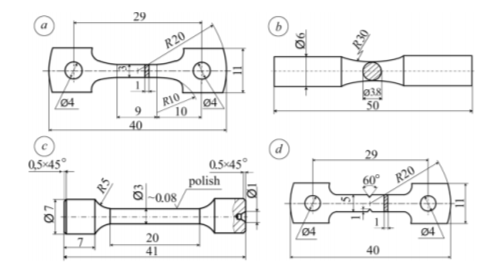
Figure 2. Mechanical test of specimens: (a) cyclic pure bending, (b) rotating bending, (c) cyclic tension, (d) and long-term static loading (Fedirko, et al.,2014, p.416, Figure 1).
The experiments included using a series of specimens with 35-70 µm gas saturation layers deep from the subsurface being treated with solid solution hardening process within different levels, 0%<K<100%, using thermo-diffusion saturation. The test results revealed that at a uniform depth in the stiffened zone, K (surface hardening level) rise from 5% up to 90% thus VT5 and VT1-0 titanium alloys having increased fatigue limit, as shown in Figure 3 and 4 (Fedirko, et al.,2014, p.417).
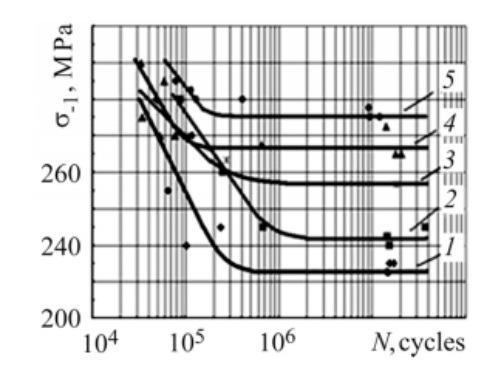
Figure 3. How surface hardening affects the durability of VT1-0 titanium alloy in rotation bending: (1) K = 5%; l = 5 µm; (2) K = 25%; (3) K = 90%; (4) K = 50%; (5) K = 70%; (2–5) l ≈ 30 µm (Fedirko, et al.,2014, p.418, Figure 3).
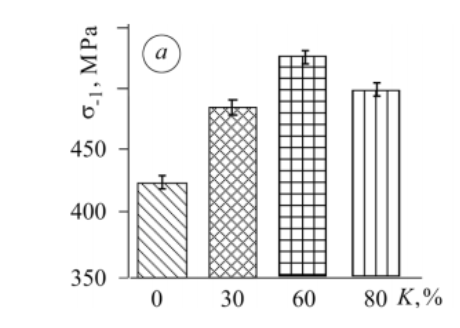
Figure 4. How the fatigue limit of titanium alloys, VT5 and OT4-1 is influenced by the surface hardening. (Fedirko, et al.,2014, p.418, Figure 4a).
The same pattern was evident for the OT4-1 alloy as shown in Figure 5
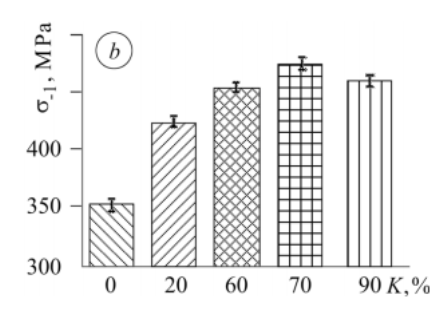
Figure 5. How the fatigue limit of the alloy is affected by the surface hardening, under the test of rotating bending for 1⋅107 cycles (Fedirko, et al.,2014, p.418, Figure 4b).
The study found that the highest increase of the fatigue limit for the VT1-0 alloy was found at K = 70%, l ≈ 30 µm and for the VT5 alloy at K = 60%, l ≈ 30 µm and for the OT4-1 alloy at K = 70%, l ≈ 45 µm (Fedirko, et al.,2014, p.418).

Figure 6. Strength in case of long term of speciments, (a) VT1-0 , (b) PT-7M, (c)OT4-1 alloys, after the load for about 1000 hours with variety level of surface hardening K (Fedirko et al.,2014, p.419, Figure 7).
Furthermore, the study found that the hardening process in the subsurface of a metal has a good impact on the performance of three of the alloys (PT-7M, OT4-1 and VT1-0) when subjected to long-term static load, as shown in Figure 6. The research indicated that when a specimen has been hardened to optimal levels, the fracture stresses increase by up to 10% after loading for 1000 hr, which makes the materials resist and stand against destruction under long-term static loads. The study concluded that the durability of the tested titanium alloys whose “subsurface layer is solid-solution-hardened to the optimal level” increases in the situation of rotating bending and pure bending and 1000 hours of long-term static load in air, by 25%-35%, 10%-15%% and 7%-10% respectively. (Fedirko, et al.,2014, p.420).
It is argued that the above study, though limited to four types of titanium alloys, offers an insight into the complex nature of understanding the link between production of metals, mechanical properties and behaviour under long term static conditions.
Koo et al., (2017) also carried out a study on the failure of metals under long term static loads, focusing on biodegradable metals, which are metals that have been developed using metal alloys such as iron, magnesium and zinc-based alloys. The purpose of these alloys is to degrade gradually with time, whilst at the same time providing mechanical strength that is required at the early stage of installation. However the complex physiological stresses induced by long term static loading make degradation unpredictable, thus posing a engineering challenge for designers. It is acknowledged that implantable devices are subjected to high loadings largely due to normal physical activities and these loadings can result in stress corrosion cracking (SCC) and fatigues due to corrosion (CF). However, Koo et al.,(2017) argue that in magnesium alloy-based biodegradable metals there can be higher stress that can cause failure of the metallic medical device. It follows that there is a need for a detailed study and research of how mechanical stress and corrosion affect each other to potentially make better alloys. To this end Koo et al.,(2017) conducted research how a long-term static stress influence magnesium alloys in terms of degradation, investigating the induced changes in mechanical integrity. It is noted that the research focused on materials used in medical devices, however it is argued that such research has wider value for the discussion on the impacts of static loading on alloy metals.
In this research, Koo et al.,(2017) investigated magnesium alloys, ZE41A (T5) and AZ31B (H24) to evaluate stress corrosion cracking, as shown in Table 1.
Table 1 Stress Corrosion Cracking Test (Koo et al., 2017, p.46, Table 1).
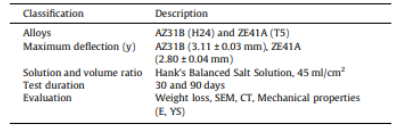
The research used EDX (energy dispersive X-ray), micro CT (micro computed tomography) and SEM (scanning electron microscopy) to examine the microstructure of alloys and to characterise the surface morphology. To replicate the static loading process, the magnesium alloys were subjected to a series of tests, summarised in Table 2, including a four-point bending test. Standard tensile tests were also carried out and the yield strength was calculated (Koo et al., 2017).
Table 2. Tensile and Flexural Mechanical Tests (Koo et al., 2017, p.46, Table 2).
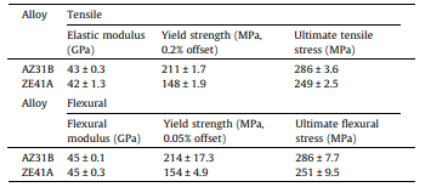
The results confirmed from four-point bending tests, showing a decrease of elastic modulus, yield strength and flexural stress as well as maximum strength, as shown in Figure 7.

Figure 7. The results of four point bending test: (a) Stress-strain curves, (b) Elastic modulus, (c) Yield strength, (d) Maximum strength of ZE41A and AZ31B. Blank = 3, corroded alloys = 2 (Koo et al., 2017, p.52, Figure 9).
The research concluded that “long-term static loading can affect degradation and mechanical integrity of Mg alloys under a stressed environment” (Koo et al., 2017, p.51). In other words, understanding of long-term static loading is critical for mechanical degradation process.
Conclusion
This essay investigated the failure of metals under long term static loads. The research finds that failure is dependent on the type of load, the time under which the material is subjected to that load and the mechanical properties of the metal. It is evident from this study that the mechanical behaviour is dependent on the production of the metal, as each production process induces stresses, strains and impurities in the material which affect the performance of that material. It is possible to predict performance under variable imposed loads and static loads, however the latter can be complex, given that the load conditions and the environment within which the material is located can vary with time, and condition. In short whilst static loads can have an impact on failure, other factors such as corrosion can affect the structural integrity of the metal which contributes to failure. It is submitted that this study indicates that whilst there is a significant bank of research and understanding on conventional metals, there is less research on the behaviour of alloys, despite the increasing use of these materials. The essay indicates that alloys are also affected by the method of production and the environmental conditions.
References
- Andreikiv, O.E. and Sas, N.B., 2006. Fracture mechanics of metallic plates under the conditions of high-temperature creep. Materials Science, 42(2), pp.210-219.
- Bhaduri, A., 2018. Mechanical Properties and Working of Metals and Alloys. London: Springer Press.
- Ellobody, E., Feng, R. and Young, B., 2014. Finite Element Analysis and Design of Metal Structures. Oxford: Elsevier.
- Forrest, P.G., 1970. Fatigue of Metals. Oxford: Elsevier.
- Fedirko, V.M., Luk’yanenko, O.H. and Trush, V.S., 2014. Influence of the diffusion saturation with oxygen on the durability and long-term static strength of titanium alloys. Materials Science, 50(3), pp.415-420.
- Gere, J.M. and Goodno, B.J., 2012. Mechanics of Materials. Cengage Learning.
- Harris, J.N., 2014. Mechanical Working of Metals: Theory and Practice. Oxford: Elsevier.
- Hosseini, S., Heidarpour, A., Collins, F. and Hutchinson, C.R., 2015. Effect of strain ageing on the mechanical properties of partially damaged structural mild steel. Construction and Building Materials, 77, pp.83-93.
- Koo, Y., Jang, Y. and Yun, Y., 2017. A study of long-term static load on degradation and mechanical integrity of Mg alloys-based biodegradable metals. Materials Science and Engineering: B, 219, pp.45-54.
- Lascoe, O.D., 1998. Handbook of Fabrication Processes. New York: ASM International.
- Lesiuk, G., Rymsza, B., Rabiega, J., Correia, J.A., De Jesus, A.M.P. and Calcada, R., 2019. Influence of loading direction on the static and fatigue fracture properties of the long term operated metallic materials. Engineering Failure Analysis, 96, pp.409-425.
- Macaulay, M., 2012. Introduction to Impact Engineering. London: Springer Science & Business Media.
- Madia, M., Ngoula, D.T., Zerbst, U. and Beier, H.T., 2017. Approximation of the crack driving force for cracks at notches under static and cyclic loading. Procedia Structural Integrity, 5, pp.875-882.
- Martin, G. and Vladimír, C., 2017. Conditions for Long-term Monitoring of Safety in Operation of Pipelines. Procedia Structural Integrity, 5, pp.614-619.
- Matta, A.K., Kodali, S.P., Ivvala, J. and Kumar, P.J., 2018. Metal Prototyping the future of Automobile Industry: A review. Materials Today: Proceedings, 5(9), pp.17597-17601.
- McKown, S.S.S.S., Shen, Y., Brookes, W.K., Sutcliffe, C.J., Cantwell, W.J., Langdon, G.S., Nurick, G.N. and Theobald, M.D., 2008. The quasi-static and blast loading response of lattice structures. International Journal of Impact Engineering, 35(8), pp.795-810.
- Mišović, M., Tadić, N. and Lučić, D., 2016. Deformation characteristics of aluminium alloys, Gradevinar, 68(3), pp. 179-189.
- National Academy Press, 1995. Manufacturing Unit Processes. [online]. Available at < https://www.nap.edu/read/4827/chapter/10 > [accessed 17th February 2019].
- Panin, S.V., Vlasov, I.V., Marushchak, P.O., Eremin, A.V., Byakov, A.V., Berto, F., Vinogradov, A.Y., Syromyatnikova, A.S. and Stankevich, R., 2017. Influence of long-term operation on structure, fatigue durability and impact toughness of 09Mn2Si pipe steel. Procedia Structural Integrity, 5, pp.401-408.
- Wang, X.J., Xu, D.K., Wu, R.Z., Chen, X.B., Peng, Q.M., Jin, L., Xin, Y.C., Zhang, Z.Q., Liu, Y., Chen, X.H. and Chen, G., 2018. What is going on in magnesium alloys?. Journal of Materials Science & Technology, 34(2), pp.245-247.
- Winzer, N., Atrens, A., Song, G., Ghali, E., Dietzel, W., Kainer, K.U., Hort, N. and Blawert, C., 2005. A critical review of the stress corrosion cracking (SCC) of magnesium alloys. Advanced Engineering Materials, 7(8), pp.659-693.
- Witte, F., 2010. The history of biodegradable magnesium implants: a review. Acta biomaterialia, 6(5), pp.1680-1692.
- Zerbst, U., Madia, M., Klinger, C., Bettge, D. and Murakami, Y., 2019. Defects as a root cause of fatigue failure of metallic components. III: Cavities, dents, corrosion pits, scratches. Engineering Failure Analysis, 97, 777-792.
Cite This Work
To export a reference to this article please select a referencing stye below:
Related Services
View allDMCA / Removal Request
If you are the original writer of this essay and no longer wish to have your work published on UKEssays.com then please click the following link to email our support team:
Request essay removal


